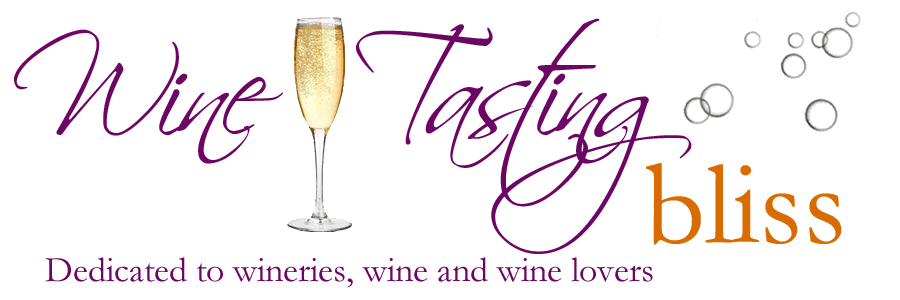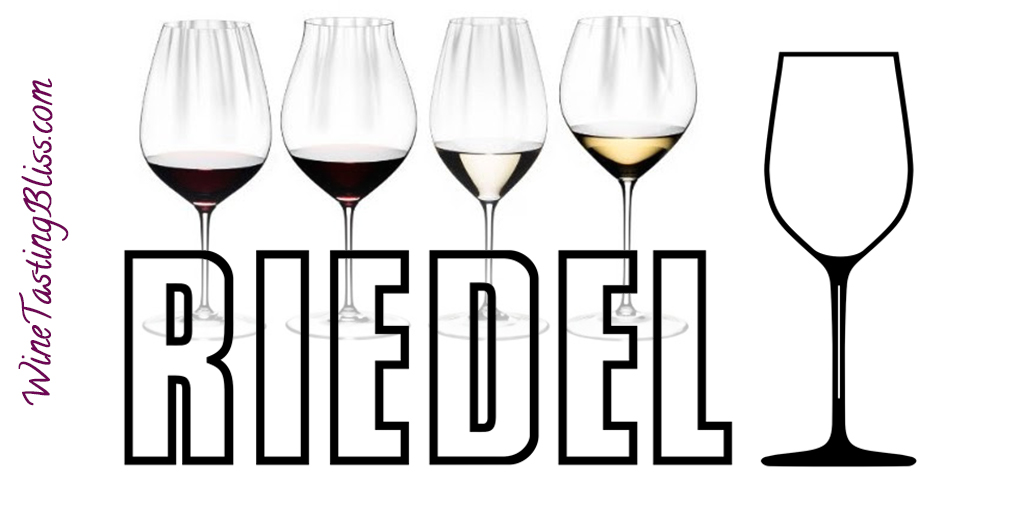When wine tasting, a lot of time is spent savoring the aroma, the appearance, the flavors, and the finish of the wine. Often, though, very little thought is given to the impact of the wine glass on every aspect of the wine tasting experience. We recently learned more on this subject through a guided exploration of Riedel wine glasses.
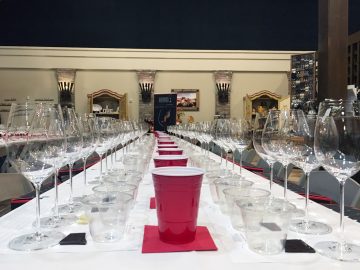 When we learned that Rubino Estates Winery was offering a “Riedel Party” we signed up immediately! The price of the ticket was less than the retail value of the glasses we would keep, with no extra charge for the fun and the knowledge gained. We arrived fashionably early and spent the time waiting for the doors to open by enjoying the happy people streaming past as they went into the Palm Event Center for a wedding.
When we learned that Rubino Estates Winery was offering a “Riedel Party” we signed up immediately! The price of the ticket was less than the retail value of the glasses we would keep, with no extra charge for the fun and the knowledge gained. We arrived fashionably early and spent the time waiting for the doors to open by enjoying the happy people streaming past as they went into the Palm Event Center for a wedding.
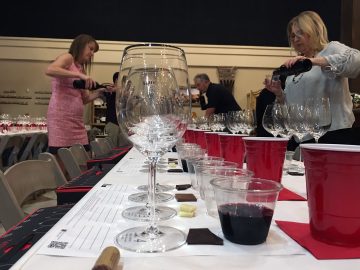 Before long, we were admitted into the Rubino tasting room to find the staff dashing around, filling plastic tumblers with four different wines. They explained that the wine pouring was intentionally done at the last minute. Since it was harvest and crush season, roving gangs of fruit flies were everywhere, and nobody wants a fruit fly in their wine! Once we were seated, many of us covered the plastic tumblers with our napkins to further foil those sneaky fruit flies.
Before long, we were admitted into the Rubino tasting room to find the staff dashing around, filling plastic tumblers with four different wines. They explained that the wine pouring was intentionally done at the last minute. Since it was harvest and crush season, roving gangs of fruit flies were everywhere, and nobody wants a fruit fly in their wine! Once we were seated, many of us covered the plastic tumblers with our napkins to further foil those sneaky fruit flies.
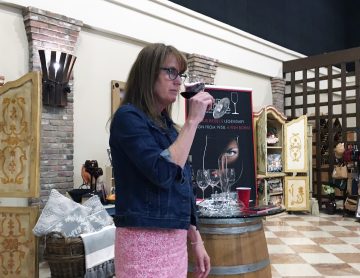 As everyone got settle in, we met Susan Durbrow, the regional sales manager for Riedel, who would be leading us through the program for the evening. She told us a bit about her background and quickly established herself as knowledgeable about wine and the wine industry. She easily got everyone in the room engaged in the fun process of learning something new about tasting wine.
As everyone got settle in, we met Susan Durbrow, the regional sales manager for Riedel, who would be leading us through the program for the evening. She told us a bit about her background and quickly established herself as knowledgeable about wine and the wine industry. She easily got everyone in the room engaged in the fun process of learning something new about tasting wine.
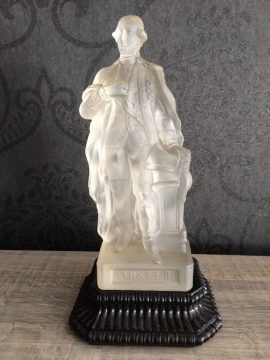
Susan began with a brief history of the Riedel company. Founder Josef Riedel the Elder was quite the manufacturing magnate in the mid 1800s, eventually owning eight glass factories. These factories produced jewelery and glass beads which developed a wide audience. He won the ‘Grand Prix’ award at the World Fair in Vienna in 1873 and was awarded an Order by the Pope. Josef became known as ‘The Glass King of the Jizera Mountains.’ Fast forward several generations of Riedels as they explored various markets for their glass, to 1873, when the Riedels won a gold medal for their all-new hollow decorative glass at the World Exhibition in Vienna. Their venture into fine stemware was firmly established. A number of wars came and went, forcing ebbs and flows to the family and its business. Today Riedel is synonymous with high-end wine glasses worldwide.
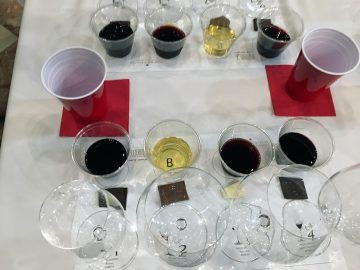 Susan next explained a bit about the tableau before each of us. Each of the plastic chalices (her term) contained a different wine varietal, associated with a Riedel glass and a square of Lindt chocolate. The plastic glasses were labeled A through D, with the Riedel glasses numbered 1 through 4. The red Solo cups were for dumping excess wine for those intending to drive home. All in all, a very intriguing and well organized setting.
Susan next explained a bit about the tableau before each of us. Each of the plastic chalices (her term) contained a different wine varietal, associated with a Riedel glass and a square of Lindt chocolate. The plastic glasses were labeled A through D, with the Riedel glasses numbered 1 through 4. The red Solo cups were for dumping excess wine for those intending to drive home. All in all, a very intriguing and well organized setting.
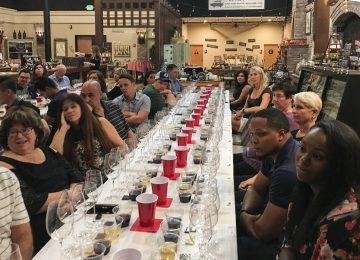 Susan described the current-era Riedal glasses as “winemaker designed.” Previous generations of Riedels used their own judgment in selecting the shape of the bowl for each target varietal. Now, panels of winemakers are convened to taste a single wine in several dozen candidate wine glasses. Over a series of rounds of “voting off the island” the panel converges on a single recommended shape for that wine varietal. The glasses we were exploring in this class were the result of this new process.
Susan described the current-era Riedal glasses as “winemaker designed.” Previous generations of Riedels used their own judgment in selecting the shape of the bowl for each target varietal. Now, panels of winemakers are convened to taste a single wine in several dozen candidate wine glasses. Over a series of rounds of “voting off the island” the panel converges on a single recommended shape for that wine varietal. The glasses we were exploring in this class were the result of this new process.
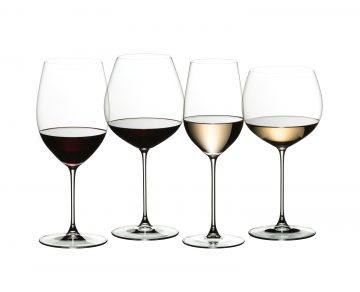 To our surprise, though, we did not start with tasting wine at all! Instead, we were each given a small bottle of very cold water. We were instructed to pour “two sips” of this water into each Riedel glass. We sipped from each glass in turn, discovering how the shape of the glass directed the water onto very different areas of the tongue. There will be wine tasting eventually, right?
To our surprise, though, we did not start with tasting wine at all! Instead, we were each given a small bottle of very cold water. We were instructed to pour “two sips” of this water into each Riedel glass. We sipped from each glass in turn, discovering how the shape of the glass directed the water onto very different areas of the tongue. There will be wine tasting eventually, right?
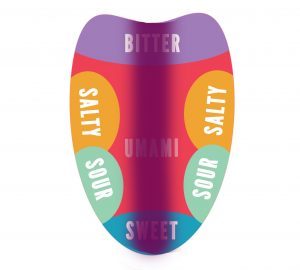 We first explored the glass identified as the “Riesling/Zinfandel” glass. We sipped the cold water to discover that the shape of the glass directed the water directly down the center of our tongue. Susan said that this focused the liquid onto the area of the tongue that is most sensitive to sweet and umami flavors, skipping the sour and salty receptors.
We first explored the glass identified as the “Riesling/Zinfandel” glass. We sipped the cold water to discover that the shape of the glass directed the water directly down the center of our tongue. Susan said that this focused the liquid onto the area of the tongue that is most sensitive to sweet and umami flavors, skipping the sour and salty receptors.
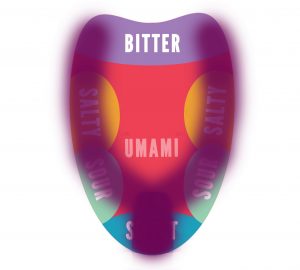 The “Oaked Chardonnay” glass was next. In this case, we found that the cold water entered across the tip of the tongue and then raced to the outer edges. This was said to highlight the positive impact of oak barrels in the aging process. Susan mentioned that her husband sold barrels, so he was particularly happy when people used wine glasses that celebrated the positive contribution of his barrels.
The “Oaked Chardonnay” glass was next. In this case, we found that the cold water entered across the tip of the tongue and then raced to the outer edges. This was said to highlight the positive impact of oak barrels in the aging process. Susan mentioned that her husband sold barrels, so he was particularly happy when people used wine glasses that celebrated the positive contribution of his barrels.
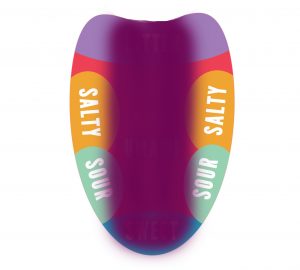 We next did the cold water test with the Riedel “Pinot Noir” glass. The water seemed to jump the tip of the tongue and then paint a broad swath down the middle. This emphasizes the earthy, umami flavors with little interaction with the sour sensors. Susan pointed out that we were using the “Old World” Pinot Noir glass, whereas the “New World” Pinot glass (not in this set) has a tulip shape. In her judgment, Livermore Pinots showed very well with this glass, while Oregon Pinots were best served in the New World glass.
We next did the cold water test with the Riedel “Pinot Noir” glass. The water seemed to jump the tip of the tongue and then paint a broad swath down the middle. This emphasizes the earthy, umami flavors with little interaction with the sour sensors. Susan pointed out that we were using the “Old World” Pinot Noir glass, whereas the “New World” Pinot glass (not in this set) has a tulip shape. In her judgment, Livermore Pinots showed very well with this glass, while Oregon Pinots were best served in the New World glass.
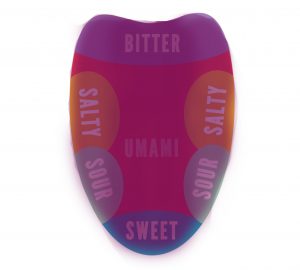 Our final water test was with Riedel’s “Cabernet Sauvignon” glass. In this case, the cold water seemed to totally cover the tongue immediately, leaving no surface behind. This allows the wine to be savored by every sensor on the tongue for a total sensory experience. For layered wines like Cabernet Sauvignon, the winemakers’s craft is exposed to the drinker in every way. It was quite surprising how different each of the wine glasses presented the cold water to the tongue.
Our final water test was with Riedel’s “Cabernet Sauvignon” glass. In this case, the cold water seemed to totally cover the tongue immediately, leaving no surface behind. This allows the wine to be savored by every sensor on the tongue for a total sensory experience. For layered wines like Cabernet Sauvignon, the winemakers’s craft is exposed to the drinker in every way. It was quite surprising how different each of the wine glasses presented the cold water to the tongue.
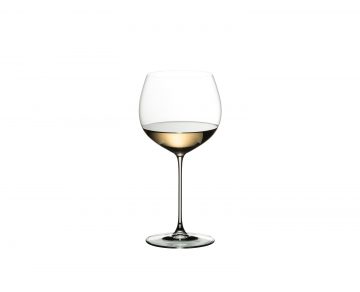
It was finally time to taste wine in these wonderful glasses! We started with a Chardonnay, in the matching glass. The aromas were lovely, as was the cascade of lightly-oaked flavors. When we poured the Chardonnay into the Pinot Noir glass, we were shocked to find that the lovely aromas were diminished and the wine showed less oak and more acid, leaving an acidic finish. The Chardonnay in the Cabernet Sauvignon glass showed a bit more fruit than in the Pinot Noir glass, but still did not show the nuanced oak that we loved in the proper glass. One wine into our tasting and our minds were already blown!
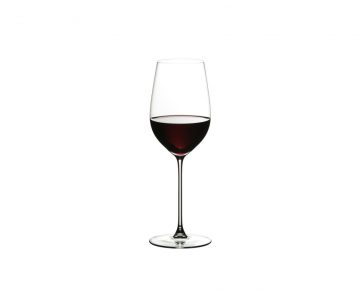
We next explored the Zinfandel wine in the Riesling/Zinfandel glass. That is, after we had taken a “repair sip” of the of the Chardonnay in the appropriate glass to sooth our battered palate. The Zin was spectacular in the proper glass. When tasted in the Chardonnay glass, however, the acid and smoky notes were emphasized, leaving everyone smacking their lips to auto-correct (Susan’s phrase) the acid overload. When we poured the Zinfandel into the Cabernet Suavignon glass, the only aroma was faint vanilla, with very thin flavors across the palate. This glass would not sell very much Zinfandel! Susan said “the glass is a tool” and it was quite apparent in this case.
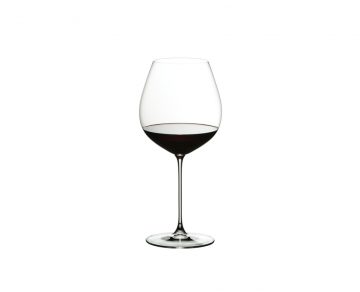
Next up was an exploration of the Pinot Noir glass. As a fan of Pinot Noir, I had been looking forward to this for at least 20 minutes! It was worth the wait. This glass presented the Pinot as a lovely experience, with a great balance of fruit and earthiness, as everything came together beautifully. When tasted in the Cabernet Sauvignon glass, the wine lost a lot of its exuberance, showing little body. Susan called it, “Plonk.” When we tasted the Pinot Noir in the Riesling/Zinfandel glass, the wine lost all aroma and presented a burning alcohol feeling down the center of the tongue. Oh, the humanity!
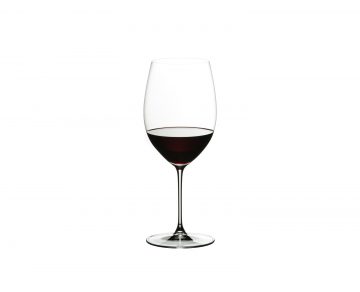
Our final glass was designed for Cabernet Sauvignon. The Cab showed wonderful notes of blackberries, cherries, and plums, both on the nose and the palate. A really wonderful advertisement for a wine that many times presents as “meh.” When we tried the Cab in the Riesling/Zin glass, it was not bad, but certainly not the flavor explosion we had just experienced. The same wine in the Pinot Noir glass was described as a “donut” wine, because there was a hole in the middle: a nice start, no real fruit body, then a faint finish. Another amazing comparison!
As we were marveling at the profound impact these glasses had on the wines, Susan showed us her favorite Riedel wine accessory: the Mamba decanter. A decanter is intended to add air to the wine to release the aromas and flavors that are not present when a wine bottle is first opened. This serpentine decanter was certainly one of the most create approaches to a pedestrian object that we had ever seen! She swooped and swirled, and even poured from the long, flared spout. Definitely a gift for that wine lover who has everything.
And then… we were done. We rinsed our glasses and packed them into the provided boxes. That’s right, these glasses were ours to keep! We thanked Susan for all the knowledge and gingerly carried our precious glasses to the car. Only six more classes and we will have a complete set!
About the Author: John grills a mean steak and is always in the market for another wine fridge. Believes that if a winery has more than 10 employees, it's probably too big. Buys wine faster than he drinks it, but who cares?
